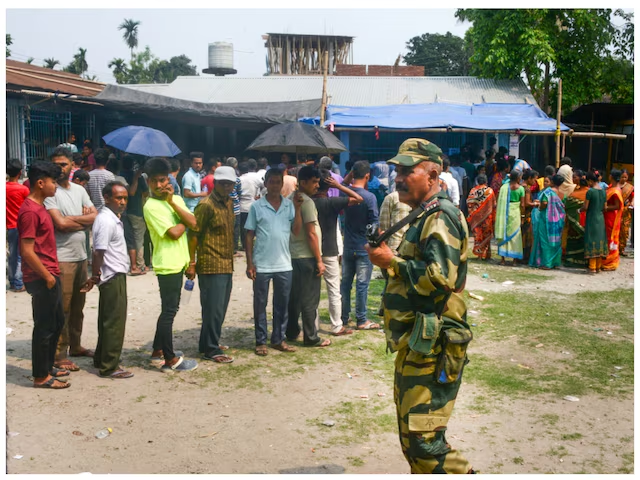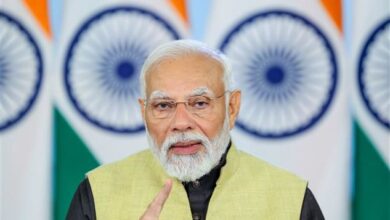In North Bengal, is TMC able to crack the code? What Elements Turn the State’s 2024 Lok Sabha Elections Into a Bipolar Contest?
Over the last ten years, West Bengal’s political landscape has drastically changed as a result of the BJP’s gains in north Bengal, seats close to the India-Bangladesh border, and places with a sizable tribal population.

With the first round of elections being over, it is reasonable to predict that the ruling Trinamool Congress (TMC) and the Bharatiya Janata Party (BJP) will engage in a bitter battle in West Bengal. However, it seems that the Congress and CPM have been confined to few marginalized areas with little sway.
The key task of the BJP in West Bengal is to retain the results of the last election, while the TMC’s main concerns are protecting its territory and making up ground lost in some regions, particularly in north Bengal and the tribal-dominated western districts known as “Jangal Mahal.”
In West Bengal, a few key elements that influence the outcome of elections for any political party include the population, the past of violence before and after the polls, intimidation, and polling booth capture. From east to west and from north to south, different electorate-related concerns exist. Variations in the relative dominance of certain populations within areas have an impact on both voting patterns and violent incidents.
Recently, the state has seen a pervasive regional division between the north and the south. These are a some of the key variables that influence West Bengali elections.
A DEMOGRAPHIC SECTION
The 2011 Census data, the most recent report to be issued, shows that the majority of people in West Bengal are Hindu, with around 27% of the population being Muslim. According to prediction estimates from many government sources, the Muslim population in the state is expected to have expanded to around 30% by 2021. Muslims and their voting habits have always been important to the state, regardless of the administration, including the Trinamool Congress and the Left Front.
Muslim votes in Bengal were not unified in favor of a single party before to 2021. They divided their votes between the Left, Congress, and Trinamool Congress. A detailed examination of the previous assembly and parliamentary elections reveals that the Congress had significant sway over the Muslim population in Birbhum, Murshidabad, and Malda.
Six Lok Sabha seats are held together by three districts. While the TMC had an overwhelming majority in the Muslim-dominated districts in south Bengal and close to the Bangladeshi border, the Left parties held influence over a few seats in north Bengal.
Nevertheless, with the 2019 elections, the situation altered. The Muslims in West Bengal shifted their allegiance to the TMC when the Citizenship Amendment Act (CAA) was introduced, the National Register of Citizens (NRC) was mentioned, and Mamata Banerjee protested it. Both Congress’s and CPM’s vote shares decreased as a result of this change in the equation.
It is difficult for the BJP to anticipate a comparable Hindu consolidation, even as Muslims in Bengal who have supported Mamata Banerjee in previous elections choose to unite in her favor.
Political analysts claim that although Trinamool Congress has a 30 percent vote share, the remaining votes need to be won.
BREACH OF THE BASTION
Just two seats in the state, Darjeeling and Asansol, were won by the BJP in 2014. The hilly North Bengali constituency of Darjeeling has long supported the BJP in the hopes that the party will back their cause for the Gorkha people and aid in the creation of a separate autonomous entity with its own set of administrative powers.
In 2014, Asansol surprised everyone by selecting the BJP. Voters who speak Hindi and are not Bengali have controlled the seat, which is home to coal mines, stone quarries, and an industrial belt. These voters are mostly Biharis.
However, the TMC’s recently constructed fortress in North Bengal and Jangalmahal, in the western portion of the state, was broken by the BJP in 2019. In north Bengal, the party took all six seats, taking four from the TMC and one from the CPM. The BJP ousted the TMC from all five seats in Jangalmahal.
Psephologists claim that as the Left’s votes were moved to the BJP, the equation in these areas shifted. An examination of the Lok Sabha results for 2014 and 2019 reveals that the BJP’s vote share increased by 22% in 2019, while the CPM’s vote share fell by 17%.
The vote share of the Left and Congress, as well as the direction of the combined vote swing, will probably have a significant impact on the BJP’s electoral fortunes. In the event that the Left and Congress manage to hold onto their positions, the BJP could have to settle with its own vote share, which was about 38% in the most recent assembly election in 2021.
Approximately 11–12 seats, mostly in Jangalmahal and north Bengal, are held by tribal and Scheduled Castes (SC) people, and they are crucial to the BJP’s electoral success in the state.
THICK NORTH-SOUTH PARTITION
The political terrain of West Bengal is characterized by a north-south division. In the perspective of national politics, it may be seen as a comparable situation. The BJP is overwhelmingly supported in the country’s north, but the southern front has so far been rebuffed by the saffron party.
In the past, the Left Front has won five of the six seats in north Bengal in the Lok Sabha elections. However, the BJP won all six seats in 2019. TMC made an attempt, but they were unable to decipher the code to access the north Bengal route. In a same vein, Mamata Banerjee has used south Bengal as a fortress, which the BJP has not yet managed to break.
GOVT PROGRAMS AGAINST CORRUPTION
The Mamata Banerjee administration offers benefits in the form of monetary initiatives, in contrast to many state governments that give things away for free. The state provides monthly financial aid or one-term allowances to approximately two dozen distinct communities, age categories, castes, and other groups.
The registered head of a family might get cash incentives ranging from Rs 500 to Rs 1,500 per month, which enables families to make a respectable income. Eventually, the family’s eligibility for the money extends to many members. The beneficiary schemes that provide the cash include Lakshmi Bhandar, Kanyashree Prakalpa, Rupashree Prakalpa, and so on.
There are claims, meanwhile, that the governing party’s members in municipalities and panchayats want a “cut” from the money intended for the recipients. A number of scams are said to exist, such as the recruiting fraud, school service scams, financial distribution for Cyclone Amphan, and others. The inquiry is ongoing in some situations.
Conversely, some recipients in rural Bengal assert that they have been able to avoid the extortion or “cut” money issue because to the Center’s DBT (Direct Benefit Transfer) programs.
India-Bangladesh Porous Boundary
Of the 42 Lok Sabha seats in total, around 12 are situated close to the 4,100 km long international border between Bangladesh and India, most of it is riverine or unfenced and is regarded as India’s most porous border.
There are several communities along the zero line that divides the two nations. The communities are separated by what is sometimes a fence and an almost invisible border. Senior BSF personnel said that despite the Border Security Force’s (BSF) significant presence, illegal crossing is still an issue and often occurs during election seasons.
RIGGING, INSTITUTION, AND VIOLENCE
The first round of the Lok Sabha elections in West Bengal on April 19 was characterized by “usual” occurrences such as booth capture, attacks on voters, party offices being set on fire, and accusations of abduction. The Election Commission of India sent out more than 218 central corporations to conduct voting in the first phase in three north Bengali constituencies: Jalpaiuri, Alipurduar, and Cooch Behar. The EC received 460 complaints claiming assaults, conflicts, and rigging from both parties despite such a large deployment.
But there have also been instances of violence, vote-rigging, and obstruction of voting places, in addition to accusations of voter intimidation, assaults, and kidnapping made by the TMC and BJP against one another.
It’s interesting to note that the TMC and BJP had “victory rallies” in the affected districts a few hours after the polls. Intimidation, violence, and retribution have been the state’s worst issues throughout every election. Given the state’s history of poll-related violence, the first round of the 2024 Lok Sabha election is but a taste of what people might expect in the state.
Both BJP and Trinamool political activists perished in post-violence in 2021. Additionally, a few CPM and Congress employees were killed. In several instances, the victims were lynched by a crowd rather than shot or hacked to death. The Calcutta High Court ordered the Central Bureau of Investigation (CBI) to look into the deaths. 52 cases have reportedly been started since then, according to sources at the central agencies.







